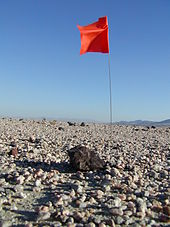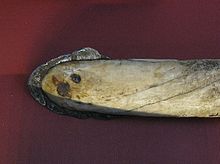Meteorite
In contrast, even relatively large stony or icy bodies such as small comets or asteroids, up to millions of tons, are disrupted in the atmosphere, and do not make impact craters.
[12] The fireball that occurs as the meteoroid passes through the atmosphere can appear to be very bright, rivaling the sun in intensity, although most are far dimmer and may not even be noticed during the daytime.
Explosions, detonations, and rumblings are often heard during meteorite falls, which can be caused by sonic booms as well as shock waves resulting from major fragmentation events.
If the meteoroid maintains a fixed orientation for some time, without tumbling, it may develop a conical "nose cone" or "heat shield" shape.
Due to the low abundance of iron meteorites in collection areas such as Antarctica, where most of the meteoric material that has fallen can be recovered, it is possible that the percentage of iron-meteorite falls is lower than 5%.
Pyrimidine and polycyclic aromatic hydrocarbons (PAHs) may have been formed in red giants or in interstellar dust and gas clouds, according to the scientists.
They represent the highly weathered remains of meteorites that fell to Earth in the remote past and were preserved in sedimentary deposits sufficiently well that they can be recognized through mineralogical and geochemical studies.
The extraterrestrial provenance was demonstrated in part through isotopic analysis of relict spinel grains, a mineral that is common in meteorites, is insoluble in water, and is able to persist chemically unchanged in the terrestrial weathering environment.
Scientists believe that these meteorites, which have all also been found in Russia and China, all originated from the same source, a collision that occurred somewhere between Jupiter and Mars.
[50] Finally, observations by the European Fireball Network, a descendant of the original Czech program that recovered Příbram, led to the discovery and orbit calculations for the Neuschwanstein meteorite in 2002.
[55] Nininger's strategy was to search for meteorites in the Great Plains of the United States, where the land was largely cultivated and the soil contained few rocks.
Between the late 1920s and the 1950s, he traveled across the region, educating local people about what meteorites looked like and what to do if they thought they had found one, for example, in the course of clearing a field.
After the discovery of a few meteorites in 1967, a public awareness campaign resulted in the finding of nearly 100 new specimens in the next few years, with many being by a single person, Ivan Wilson.
In the area of the finds, the ground was originally covered by a shallow, loose soil sitting atop a hardpan layer.
[69] European teams, starting with a consortium called "EUROMET" in the 1990/91 season, and continuing with a program by the Italian Programma Nazionale di Ricerche in Antartide have also conducted systematic searches for Antarctic meteorites.
In the extremely arid climate, there has been relatively little weathering or sedimentation on the surface for tens of thousands of years, allowing meteorites to accumulate without being buried or destroyed.
In 1986–87, a German team installing a network of seismic stations while prospecting for oil discovered about 65 meteorites on a flat, desert plain about 100 kilometres (62 mi) southeast of Dirj (Daraj), Libya.
A few years later, a desert enthusiast saw photographs of meteorites being recovered by scientists in Antarctica, and thought that he had seen similar occurrences in northern Africa.
The find locations were generally in regions known as regs or hamadas: flat, featureless areas covered only by small pebbles and minor amounts of sand.
Included among these are a large number of lunar and Martian meteorites, making Oman a particularly important area both for scientists and collectors.
Early expeditions to Oman were mainly done by commercial meteorite dealers, however, international teams of Omani and European scientists have also now collected specimens.
[citation needed] Meteorites have figured into human culture since their earliest discovery as ceremonial or religious objects, as the subject of writing about events occurring in the sky and as a source of peril.
[79] Although the use of the metal found in meteorites is also recorded in myths of many countries and cultures where the celestial source was often acknowledged, scientific documentation only began in the last few centuries.
The cult in the Temple of Artemis at Ephesus, one of the Seven Wonders of the Ancient World, possibly originated with the observation and recovery of a meteorite that was understood by contemporaries to have fallen to the earth from Jupiter, the principal Roman deity.
In 1915, a 61-kilogram (135 lb) iron meteorite was found in a Sinagua (c. 1100–1200 AD) burial cyst near Camp Verde, Arizona, respectfully wrapped in a feather cloth.
He reported "a loud noise that sounded like a thunder was heard in the sky; a giant star, almost like the moon, appeared in the southeast" and later finding the crater and the still-hot meteorite within, nearby.
The German physicist, Ernst Florens Chladni, was the first to publish (in 1794) the idea that meteorites might be rocks that originated not from Earth, but from space.
[89] It took nearly ten years before a general acceptance of the origin of meteorites was achieved through the work of the French scientist Jean-Baptiste Biot and the British chemist, Edward Howard.
[90] Biot's study, initiated by the French Academy of Sciences, was compelled by a fall of thousands of meteorites on 26 April 1803 from the skies of L'Aigle, France.
[94] John Lewis has compiled some of these reports, and summarizes, "No one in recorded history has ever been killed by a meteorite in the presence of a meteoriticist and a medical doctor" and "reviewers who make sweeping negative conclusions usually do not cite any of the primary publications in which the eyewitnesses describe their experiences, and give no evidence of having read them".










